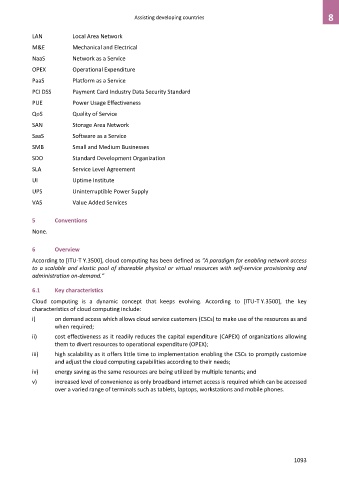Page 1101 - Cloud computing: From paradigm to operation
P. 1101
Assisting developing countries 8
LAN Local Area Network
M&E Mechanical and Electrical
NaaS Network as a Service
OPEX Operational Expenditure
PaaS Platform as a Service
PCI DSS Payment Card Industry Data Security Standard
PUE Power Usage Effectiveness
QoS Quality of Service
SAN Storage Area Network
SaaS Software as a Service
SMB Small and Medium Businesses
SDO Standard Development Organization
SLA Service Level Agreement
UI Uptime Institute
UPS Uninterruptible Power Supply
VAS Value Added Services
5 Conventions
None.
6 Overview
According to [ITU-T Y.3500], cloud computing has been defined as "A paradigm for enabling network access
to a scalable and elastic pool of shareable physical or virtual resources with self-service provisioning and
administration on-demand."
6.1 Key characteristics
Cloud computing is a dynamic concept that keeps evolving. According to [ITU-T Y.3500], the key
characteristics of cloud computing include:
i) on demand access which allows cloud service customers (CSCs) to make use of the resources as and
when required;
ii) cost effectiveness as it readily reduces the capital expenditure (CAPEX) of organizations allowing
them to divert resources to operational expenditure (OPEX);
iii) high scalability as it offers little time to implementation enabling the CSCs to promptly customize
and adjust the cloud computing capabilities according to their needs;
iv) energy saving as the same resources are being utilized by multiple tenants; and
v) increased level of convenience as only broadband internet access is required which can be accessed
over a varied range of terminals such as tablets, laptops, workstations and mobile phones.
1093

